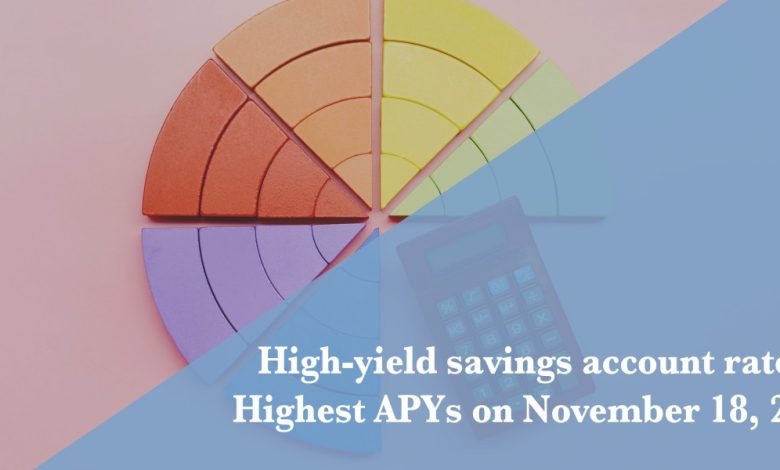Best high-yield savings account rates Tuesday, Nov. 18, 2025: Up to 5.00% APY

The best high-yield savings accounts are hitting rates up to 5.00% APY as of Nov. 18, 2025—and that’s genuinely impressive compared to the FDIC’s recorded national average of 0.40% APY. If you’re serious about making your money work harder, opting for a high-yield account over a traditional savings account is one of the best moves you can make.
Whether you’re focused on building an emergency fund, saving up for that dream vacation, thinking about investing in precious metals, or planning for retirement, putting your cash into a high-yield savings account just makes sense. You’re not taking on any real risk, but you’re potentially earning hundreds more per year than you would in a traditional account.
The three highest-APY accounts we’ve identified are as follows:
Today’s highest savings account rates
Fortune has partnered with the financial industry consultants at Curinos to give you an accurate look at the highest savings account rates on the market. Varo Money, Axos Bank, and Newtek Bank currently offer the highest yields. Read on to see our full list of HYSAs and find the one that’s right for your needs.
What the Fortune/Curinos partnership means for you
We rely on Curinos—a firm with over thirty years tracking financial services data—to keep tabs on what rates banks are offering. Each business day, we get a report from Curinos with updated data on savings and CD APYs from a wide range of financial institutions. We build our list by doing the legwork so you don’t have to.
History of savings account rates
While the average savings account rate has increased from the lows seen from 2020 to 2022, it’s still far below the APYs available on the most generous high-yield savings accounts on our list.
Why should you choose a high-yield savings account?
Real quick, let’s note “high-yield savings account” isn’t technically its own special account category. It’s just what we call any savings account offering rates that are noticeably higher than what you’ll find at your average bank. Financial professionals use the term to distinguish them from the rest of the pack.
The difference usually comes down to this: traditional banks with branch locations tend to offer lower rates because they’re paying for physical infrastructure. Online banks offering high-yield accounts have stripped things down—no branches, fewer services—which means they can pass those savings on to you in the form of higher earning rates.
If you’re comfortable banking online and you want to maximize what you earn, switching to a high-yield savings account could transform your returns. We’re talking about potentially hundreds of dollars more annually, depending on how much you deposit and what APY your HYSA offers.
How much interest can you earn with a higher APY?
Here’s a hypothetical: take $5,000 sitting untouched for a year. In an account earning 5.00% APY, you’d make significantly more than you would in a 0.40% APY account, as shown by the estimates below.
| Initial Deposit | Estimated Interest | |
|---|---|---|
| 0.40% APY | $5,000 | $22 |
| 5.00% APY | $5,000 | $256 |
| 0.40% APY | |
|---|---|
| $5,000 | |
| $22 | |
| 5.00% APY | |
| $5,000 | |
| $256 |
Moving your money from a traditional account to a high-yield option is one of the easiest financial moves you can make—and should pay off in spades.
What should you look for in a high-yield savings account?
When you’re evaluating accounts, keep these priorities in mind:
- Strong interest rates. Hunt for a competitive APY that will genuinely boost your earnings, not just a minor difference.
- Low or no minimums. Many high-yield accounts don’t require you to bring a big chunk of cash upfront, which is great if you’re just getting started on your saving journey.
- No monthly fees. Avoid accounts that charge you just to hold your money—those fees eat directly into your interest.
- Easy access to your funds. Make sure you can withdraw or transfer money when you need it, and pay attention to withdrawal limits or foreign ATM charges.
- Security. Confirm your account is FDIC-insured if it’s at a bank, or NCUA-insured if it’s a credit union. That’s your safety net.
One important thing to be aware of is that you’ll owe taxes on whatever interest you earn.
Check Out Our Daily Rates Reports
Frequently asked questions
Are savings account rates going to fall?
It’s possible. When the Federal Reserve adjusts its benchmark rate, banks typically follow suit. Since the Fed started cutting rates in late 2025—which is good news for people looking to borrow, but less so for savers—there’s a possibility some banks will decrease savings account rates accordingly.
Can I lose money in a high-yield savings account?
Before you open an account, make absolutely sure it’s FDIC or NCUA insured. That protection covers your deposits up to a $250,000 maximum per institution. Unlike funds invested in the stock market, your money in a savings account isn’t at risk of wild swings. That said, if inflation runs ahead of your APY, you could lose purchasing power over time.
Is a high-yield savings account still worth it?
Yes. Even with recent Fed rate cuts, plenty of high-yield savings accounts are still offering APYs approaching or even above 4.00%. They remain one of the smartest, lowest-risk ways to earn noteworthy interest on your money while keeping it accessible. If you’re willing to lock your money away, a CD might potentially give you a better rate—but for flexibility, a high-yield savings account is tough to beat.






